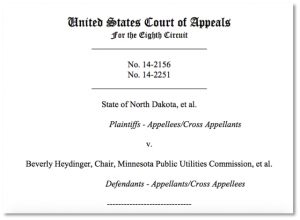Justin Gundlach
Climate Law Fellow
 As round after round has passed in the political and legal struggle at the federal level over regulating sources of greenhouse gas (GHG) emissions, states have rushed in to try to fill the void. Minnesota sought to do so in 2007 when it passed the Next Generation Energy Act. That Act defines the emissions footprint of Minnesota’s retail electricity market—including both in-state generation and imports from other states—and establishes several prohibitions to prevent that footprint from growing.
As round after round has passed in the political and legal struggle at the federal level over regulating sources of greenhouse gas (GHG) emissions, states have rushed in to try to fill the void. Minnesota sought to do so in 2007 when it passed the Next Generation Energy Act. That Act defines the emissions footprint of Minnesota’s retail electricity market—including both in-state generation and imports from other states—and establishes several prohibitions to prevent that footprint from growing.
In North Dakota v. Heydinger, several entities that generate electricity in coal-fired facilities within and outside of Minnesota, and the state of North Dakota which is home to several such entities, challenged the Minnesota Act. A federal district court ruled in 2014 that Minnesota’s Act was unconstitutional for impermissibly regulating out-of-state commercial transactions. The state appealed that decision, and, on June 15, 2016, a three-judge panel of the Federal Court of Appeals for the Eighth Circuit upheld the district court’s decision—but not its reasoning. The judges’ differing opinions are discussed in more detail below the jump.
Minnesota has not been alone in trying to reduce the emissions intensity of its particular corner of the decidedly inter-state electricity sector. Nor is it alone in getting sued over its attempt. Similar suits have been brought in more than a dozen other states, including Colorado and California. Those suits tend to base their challenges to state-level policies on either the U.S. Constitution’s (dormant) Commerce Clause or its Supremacy Clause. The first inhibits states from regulating interstate commerce (even where the federal government has not done so). The second is the basis for preemption of state law by a conflicting federal statute. Crucially, the latter is treated by courts as a statutory question rather than a constitutional one, meaning that a court hearing both sorts of argument should ground its decision in the latter if possible, in accordance with the canon against making avoidable constitutional interpretations. Both types of argument featured in the Eighth Circuit’s decision in North Dakota v. Heydinger.
Minnesota’s Next Generation Energy Act creates three important prohibitions. Starting on August 1, 2009, no person shall:
(1) construct within the state a new large energy facility[1] that would contribute to statewide power sector carbon dioxide emissions;
(2) import or commit to import from outside the state power from a new large energy facility that would contribute to statewide power sector carbon dioxide emissions; or
(3) enter into a new long-term power purchase agreement that would increase statewide power sector carbon dioxide emissions. For purposes of this section, a long-term power purchase agreement means an agreement to purchase 50 megawatts of capacity[2] or more for a term exceeding five years.
Although not a prohibition, subsection (4) of Minn. Stat. 216H.03 is also notable: it provides for an exception if a large new energy facility offsets its emissions.
The Eighth Circuit panel found these prohibitions unlawful for divergent reasons.
Judges Murphy and Collotton agreed that the second and third of these prohibitions conflict with federal law and are therefore preempted. Judge Murphy focused on the Federal Power Act, noting that “since the import provision bans contracts for power from new large power plants, it thus bans wholesale sales of electric energy in interstate commerce.” Because this ban purports to usurp the authority assigned to the Federal Energy Regulatory Commission’s by the Federal Power Act, it conflicts impermissibly with—and must give way to—that Act. To this Judge Collotton added that the Minnesota Act’s offset provision is also in conflict with and therefore preempted by the Clean Air Act, the exclusive source of authority for the regulation of interstate emissions.
Judge Loken took a different approach to the case, concluding that the second and third prohibitions amounted to Minnesota telling electricity-generating entities in Wisconsin, North Dakota, and elsewhere to whom they could sell electricity and how—an unconstitutionally “extraterritorial” regulation. This conclusion rested on a particular understanding (according to Judge Murphy, a misunderstanding) of how the electricity grid works. It also (as Judge Collotton pointed out) ignored the canon mentioned above regarding avoidable constitutional interpretation. Finally (Judge Murphy again), it ignored that “[a] state may subject out of state companies to its laws when they enter into commerce within the state without violating any extraterritoriality principle.”
In addition to being a source of disagreement within the Heydinger panel, Judge Loken’s dormant Commerce Clause analysis is also at odds with the Ninth Circuit’s analysis in the Rocky Mountain Farmers decision (from which the Supreme Court denied certiorari in 2014). That case arose from a challenge to California’s Low Carbon Fuel Standard and considered the extraterritoriality of that regulation, which also focused on carbon intensity. Thus while Judge Loken’s opinion does not create a clear circuit split, it does highlight that Rocky Mountain Farmers was not the final word on the question of whether and how the Commerce Clause limits state efforts to restrict the carbon intensity of energy used by their citizens.
The Heydinger decision’s preemption analysis, backed up by the Supreme Court’s recent clarifications of the scope of FERC’s authority under the Federal Power Act in FERC v. Electric Power Suppliers Association and CPV Maryland, LLP v. Talen Energy Marketing, sends a clear signal that states eager to regulate GHG emissions must steer well clear of the wholesale markets regulated by FERC pursuant to the Federal Power Act.
[1] The Act defines “new large energy facility” in a way that encompasses base load coal-fired power plants and excludes most other types of generation facility.
[2] Capacity markets do not trade in electric energy, but in the potential to generate and transmit such energy. Load serving entities contract for capacity as well as energy to ensure that load will not outstrip what they can supply months or years in the future.




